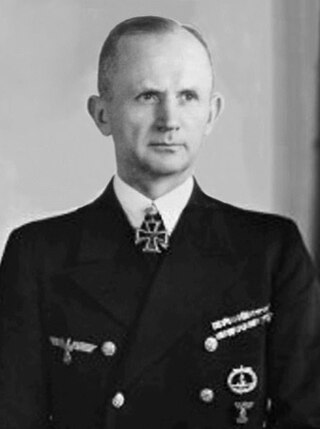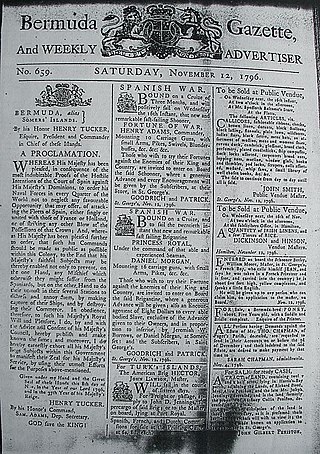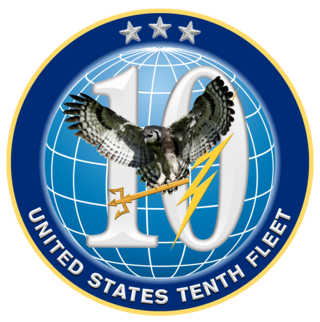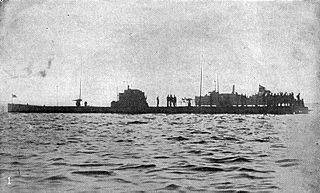
Karl Dönitz was a German navy officer who following Adolf Hitler's suicide, succeeded him as head of state of Nazi Germany in May 1945, holding the position until the dissolution of the Flensburg Government following Germany's unconditional surrender to the Allies days later. As Supreme Commander of the Navy beginning in 1943, he played a major role in the naval history of World War II.

The Laconia incident was a series of events surrounding the sinking of a British passenger ship in the Atlantic Ocean on 12 September 1942, during World War II, and a subsequent aerial attack on German and Italian submarines involved in rescue attempts. RMS Laconia, carrying 2,732 crew, passengers, soldiers, and prisoners of war, was torpedoed and sunk by U-156, a German U-boat, off the West African coast. Operating partly under the dictates of the old prize rules, the U-boat's commander, Korvettenkapitän Werner Hartenstein, immediately commenced rescue operations. U-156 broadcast her position on open radio channels to all Allied powers nearby, and was joined by several other U-boats in the vicinity.

A navy, naval force, military maritime fleet, war navy, or maritime force is the branch of a nation's armed forces principally designated for naval and amphibious warfare; namely, lake-borne, riverine, littoral, or ocean-borne combat operations and related functions. It includes anything conducted by surface ships, amphibious ships, submarines, and seaborne aviation, as well as ancillary support, communications, training, and other fields.

The Battle of the Atlantic, the longest continuous military campaign in World War II, ran from 1939 to the defeat of Nazi Germany in 1945, covering a major part of the naval history of World War II. At its core was the Allied naval blockade of Germany, announced the day after the declaration of war, and Germany's subsequent counter-blockade. The campaign peaked from mid-1940 through to the end of 1943.

The submarine film is a subgenre of war film in which most of the plot revolves around a submarine below the ocean's surface. Films of this subgenre typically focus on a small but determined crew of submariners battling against enemy submarines or submarine-hunter ships, or against other problems ranging from disputes amongst the crew, threats of mutiny, life-threatening mechanical breakdowns, or the daily difficulties of living on a submarine.

Submarine warfare is one of the four divisions of underwater warfare, the others being anti-submarine warfare, mine warfare and mine countermeasures.

Unrestricted submarine warfare is a type of naval warfare in which submarines sink merchant ships such as freighters and tankers without warning. The use of unrestricted submarine warfare has had significant impacts on international relations in regards to both the First World War and the Second World War. Its history has been dominated by German decision making.

Commerce raiding is a form of naval warfare used to destroy or disrupt logistics of the enemy on the open sea by attacking its merchant shipping, rather than engaging its combatants or enforcing a blockade against them.

Anti-submarine warfare is a branch of underwater warfare that uses surface warships, aircraft, submarines, or other platforms, to find, track, and deter, damage, or destroy enemy submarines. Such operations are typically carried out to protect friendly shipping and coastal facilities from submarine attacks and to overcome blockades.
Naval strategy is the planning and conduct of war at sea, the naval equivalent of military strategy on land.

HMS Brilliant was an Apollo-class cruiser of the British Royal Navy which served from 1893 to 1918 in various colonial posts and off the British Isles as a hastily converted minelayer during the First World War.

The U.S. Tenth Fleet is a functional formation and a numbered fleet in the United States Navy. It was first created as an anti-submarine warfare coordinating organization during the Battle of the Atlantic in the Second World War. It was reactivated as a force provider for Fleet Cyber Command on 29 January 2010. U.S. Tenth Fleet serves as the numbered fleet for U.S. Fleet Cyber Command and exercises operational control of assigned naval forces to coordinate with other naval, coalition and Joint Task Forces to execute the full spectrum of cyber, electronic warfare, information operations, and signal intelligence capabilities and missions across the cyber, electromagnetic, and space domains.

SM U-53 was one of the six Type U 51 U-boats of the Imperial German Navy during the First World War. While in command of U-53 her first captain Hans Rose became the 5th ranked German submarine ace of World War I sinking USS Jacob Jones and 87 merchant ships for a total of 224,314 gross register tons (GRT).

The U-boat campaign from 1914 to 1918 was the World War I naval campaign fought by German U-boats against the trade routes of the Allies, largely in the seas around the British Isles and in the Mediterranean, as part of a mutual blockade between the German Empire and the United Kingdom.

The Atlantic U-boat campaign of World War I was the prolonged naval conflict between German submarines and the Allied navies in Atlantic waters—the seas around the British Isles, the North Sea and the coast of France.

Charles Cooper Penrose-Fitzgerald was a vice admiral in the Royal Navy.

The convoy—a group of merchantmen or troopships traveling together with a naval escort—was revived during World War I (1914–18), after having been discarded at the start of the Age of Steam. Although convoys were used by the Royal Navy in 1914 to escort troopships from the Dominions, and in 1915 by both it and the French Navy to cover their own troop movements for overseas service, they were not systematically employed by any belligerent navy until 1916. The Royal Navy was the major user and developer of the modern convoy system, and regular transoceanic convoying began in June 1917. They made heavy use of aircraft for escorts, especially in coastal waters, an obvious departure from the convoy practices of the Age of Sail.

United States Navy operations during World War I began on April 6, 1917, after the formal declaration of war on the German Empire. The United States Navy focused on countering enemy U-boats in the Atlantic Ocean and the Mediterranean Sea while convoying men and supplies to France and Italy. Because of United States's late entry into the war, her capital ships never engaged the German fleet and few decisive submarine actions occurred.
At the start of World War II, the Royal Navy was the strongest navy in the world, with the largest number of warships built and with naval bases across the globe. It had over 15 battleships and battlecruisers, 7 aircraft carriers, 66 cruisers, 164 destroyers and 66 submarines. With a massive merchant navy, about a third of the world total, it also dominated shipping. The Royal Navy fought in every theatre from the Atlantic, Mediterranean, freezing Northern routes to Russia and the Pacific Ocean.

The Anti-Submarine Division its original name, was the former anti-submarine warfare, planning and prevention directorate of the Admiralty Department from 1912 to 1963.
















